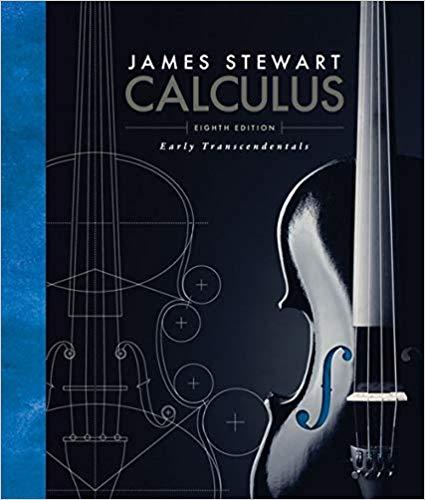
Calculus: Early Transcendentals, 8th Edition
Authors: James Stewart
ISBN-13: 978-1285741550
See our solution for Question 4E from Chapter 1.1 from Stewart's Calculus, 8th Edition.
Problem 4E
Chapter:
Problem:
The graphs of f and g are given…
Step-by-Step Solution
Step 1
We are given graphs of $f$ and $g$
https://imgur.com/n1vzfpn
Step 2: (a)
The values of $f(-4)$ and $g(3)$
https://imgur.com/JWy37O9
As shown in the Figure, we draw a vertical line at x=-4 that joins curve of f. From there we draw a horizontal line to cut Y axis at -2: Therefore, \[f\left( { - 4} \right) = - 2\]As shown in the Figure, we draw a vertical line at x=3 that joins curve of g. From there we draw a horizontal line to cut Y axis at 4: Therefore, \[g\left( 3 \right) = 4\]
Step 3: (b)
As shown in the figure below:
https://imgur.com/H6kJrzx
The $f$ and $g$ are equal when they intersect, So the points are \[\begin{array}{l}f\left( { - 2} \right) = g\left( { - 2} \right)\,\,\\f\left( 2 \right) = g\left( 2 \right)\end{array}\]Therefore, \[\left( {2, - 2} \right)\]
Step 4: (c)
Solution of equation $f(x) =1$
In the given curve we draw a horizontal line at y=1 cutting the graph of $f(x)$. From the intersection point we draw a vertical line to cut X axis at X=-3:
https://imgur.com/1L2eXQQ
Therefore, \[x = - 3\]
Step 5: (d)
As shown in the curve, we find that $f(x)$ is decreasing on the interval x=0 and x=4Therefore, \[\left[ {0,4} \right]\]
Step 6: (e)
Domain of $f(x)$ is shown in green boundary and Range is shown in magenta
https://imgur.com/S77AOjo
So Domain and Range are \[\begin{array}{l}{D_f} = \left[ { - 4,4} \right]\\{R_f} = \left[ { - 2,3} \right]\end{array}\]
Step 7: (f)
Domain of $g(x)$ is shown in green boundary and Range is shown in magenta
https://imgur.com/Xvdnizu
So Domain and Range are \[\begin{array}{l}{D_g} = \left[ { - 4,3} \right]\\{R_g} = \left[ {0.5,4} \right]\end{array}\]
We are given graphs of $f$ and $g$
https://imgur.com/n1vzfpn
Step 2: (a)
The values of $f(-4)$ and $g(3)$
https://imgur.com/JWy37O9
As shown in the Figure, we draw a vertical line at x=-4 that joins curve of f. From there we draw a horizontal line to cut Y axis at -2: Therefore, \[f\left( { - 4} \right) = - 2\]As shown in the Figure, we draw a vertical line at x=3 that joins curve of g. From there we draw a horizontal line to cut Y axis at 4: Therefore, \[g\left( 3 \right) = 4\]
Step 3: (b)
As shown in the figure below:
https://imgur.com/H6kJrzx
The $f$ and $g$ are equal when they intersect, So the points are \[\begin{array}{l}f\left( { - 2} \right) = g\left( { - 2} \right)\,\,\\f\left( 2 \right) = g\left( 2 \right)\end{array}\]Therefore, \[\left( {2, - 2} \right)\]
Step 4: (c)
Solution of equation $f(x) =1$
In the given curve we draw a horizontal line at y=1 cutting the graph of $f(x)$. From the intersection point we draw a vertical line to cut X axis at X=-3:
https://imgur.com/1L2eXQQ
Therefore, \[x = - 3\]
Step 5: (d)
As shown in the curve, we find that $f(x)$ is decreasing on the interval x=0 and x=4Therefore, \[\left[ {0,4} \right]\]
Step 6: (e)
Domain of $f(x)$ is shown in green boundary and Range is shown in magenta
https://imgur.com/S77AOjo
So Domain and Range are \[\begin{array}{l}{D_f} = \left[ { - 4,4} \right]\\{R_f} = \left[ { - 2,3} \right]\end{array}\]
Step 7: (f)
Domain of $g(x)$ is shown in green boundary and Range is shown in magenta
https://imgur.com/Xvdnizu
So Domain and Range are \[\begin{array}{l}{D_g} = \left[ { - 4,3} \right]\\{R_g} = \left[ {0.5,4} \right]\end{array}\]